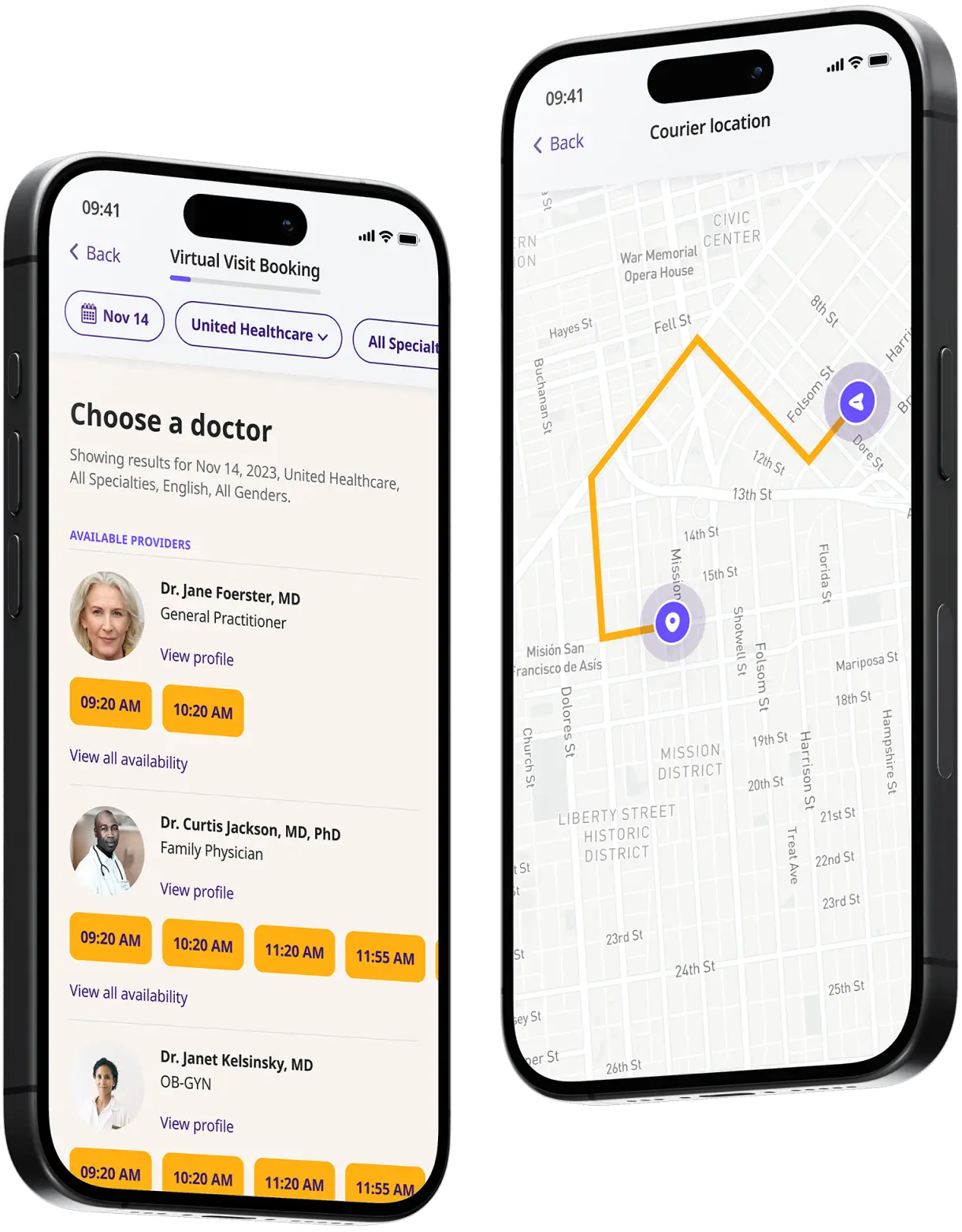Get an Indapamide Prescription Online
Get an indapamide prescription online from licensed virtual doctors to manage high blood pressure or fluid retention effectively.


Available in 50 states. Insurance accepted.
Fast
virtual visits
24/7 care
assistants
Prescriptions
as needed

24/7 Personal Care
Consult with a physician in 15 minutes, refill an Rx or chat with our care assistants.

Affordable & Convenient
See your cost upfront and get treatment for hundreds of different conditions.

Insurance Accepted
We accept most major insurance plans, making healthcare easy and affordable.
See If Delivery Is Available Near You
Delivery Not Available
Enter your ZIP code to check if prescription delivery is available in your area and how soon your meds could arrive.
How to get started
Choose your doctor, start a virtual visit, and have your prescriptions sent to your preferred pharmacy for pickup — all in just a few easy steps.
Choose a doctor
Choose a physician by availability, specialty, ratings, and more.

Start your video visit
Connect with a doctor in minutes on a secure video call.

Get your prescription
Pick up your meds or have them delivered in as little as an hour.

Available in 50 states. Insurance accepted.
One-Time
Physician Visit
One-time visit with a physician for diagnosis, treatment, Rx, labs, referrals, and doctor’s notes.
Accepted Insurances
See why people turn to DrHouse...
As seen in

Indapamide (Generic Lozol)
What Is Indapamide?
Indapamide is a medication classified as a thiazide-like diuretic – a drug that is designed to help remove excess water and salt from the body. This is done through the urine and if left untreated can lead to conditions such as water retention and high blood pressure, both of which can present themselves as serious conditions particularly further down the line.
How Does Indapamide Work?
The primary function of Indapamide is to act on the kidneys to block the process of reabsorbing sodium and chloride ions from the urine and passing it back to the bloodstream. The way this works is that it attaches to and inhibits the sodium-chloride symporter, reducing the amount of sodium that can be reabsorbed into the blood.
This helps to prevent water retention and high levels of salt in the body. In the process of doing this it also helps the blood vessels to relax and widen which allows more blood to flow through. This brings blood pressure down and reduces the chance of more serious conditions such as a heart attack from happening.
What Is Indapamide Used For?
While Indapamide is primarily used for the treatment of high blood pressure, it also has a few other uses that it could be prescribed for. This includes:
Edema – Edema is when fluids build up in the body and can be as a result of medical conditions such as heart failure, kidney issues, or problems with the liver. Indapamide increases the amount of urine you produce which in turn removes fluid from the body and can help with the symptoms accompanied with Edema such as shortness of breath and swelling.
Heart issues – There are many cardiovascular disorders that Indapamide can treat thanks to its blood-pressure-lowering properties. By opening the blood vessels it prevents them from becoming blocked and reduces the chances of things such as a heart attack, stroke or other related problems.
What Are the Side Effects of Indapamide?
Indapamide is a very useful medication, but as with any treatment, there is a chance of some side effects occurring that it’s important to be aware of. These include:
Most common side effects:
These are some of the more common side effects of taking Indapamide. Be sure to consult your healthcare provider if you are worried about any of these.
- Frequent Urination
- Dizziness or lightheadedness
- Fainting
- Fatigue or feeling weak
- Skin reactions
- A change in your kidney function
- Muscle cramps
- Nausea, vomiting and stomach upset
- Low blood potassium
More serious side effects
These are some of the more serious side effects of Indapamide – be sure to call an ambulance if you experience any of these.
- Seizures
- Swelling of the face, ankles and hands
- Unusual tiredness and weakness
- Trouble breathing
- Drowsiness and feeling unable to stay awake
How to Take Indapamide?
When taking Indapamide, it’s important to follow your medical professional’s advice and guidance to ensure it works properly and side effects are minimized.
The dosage you take can depend on your medical condition and how you respond so listen to your doctor on how much to take and how often to do so. It tends to be given once a day and during the morning so you don’t need to keep getting up to go to the toilet. It can be swallowed whole and with or without food. If you forget to take a dose, be sure to take it as soon as you remember.
Frequently Asked Questions About Indapamide
What Are the Most Common Side Effects of Indapamide?
The main side effects of taking Indapamide include frequent urination, dizziness or lightheadedness, and fatigue or feeling weak. More serious side effects can occur such as swelling of the face, ankles, and hands, breathing difficulty, drowsiness, and feeling unable to stay awake.
As with any medication, it’s important to speak to your doctor before taking this medication to ensure that you do not have any contraindications.
Be sure to also let your doctor know if you experience any side effects as soon as possible so they can be addressed quickly.
If you have difficulty breathing or significant drowsiness seek immediate medical care.
What to Avoid While Taking Indapamide?
When taking Indapamide you should avoid the following:
- Alcohol – Alcohol can lower your blood pressure and may enhance some side effects of Indapamide.
- High-sodium foods – Consuming too much salt can counteract the blood pressure-lowering effects of the medication.
- Dehydration – Diuretics like indapamide increase urine output, so it’s easier to become dehydrated. Avoid activities that could cause dehydration.
- Potassium supplements – They can cause high levels of potassium in the blood (hyperkalemia) when taken with indapamide.
- Medication – Medication such as NSAIDs, blood pressure medication, lithium, and some anti-diabetic medications can either directly interact with Indapamide or reduce its effectiveness. Make sure to speak to your doctor before taking any other medications while on Indapamide.
The list above is not exhaustive. Be sure to speak to your healthcare provider for more information on what you should and shouldn’t do while taking Indapamide.
How Long Does It Take for Indapamide to Work?
Indapamide can start to work within a few hours of taking it, however, it may take up to a week to see any noticeable effects and up to 12 weeks to see the full effect.
Indapamide doesn’t cure blood pressure but it helps to keep it at a healthy level.
It is important to keep taking Indapamide even if you don’t feel any different. It is also important to speak to your doctor if you are not seeing any improvements after 12 weeks as they may need to adjust your dosage or try an alternative medication.
What Is the Typical Dosage for Indapamide?
The dosage will depend on the individual and the medical condition being treated. The usual adult starting dose is between 1.25-2.5mg once a day and can be increased up to 5mg daily if needed.
It is important to follow your doctor’s instructions when taking Indapamide – do not take more or less than prescribed as this could either reduce its effectiveness or cause serious side effects.
Do You Need a Prescription for Indapamide?
Yes, Indapamide is a prescription-only medication and you will need to speak with a doctor before being able to obtain it.
Can You Get Indapamide Over-The-Counter (OTC)?
No, Indapamide is a prescription-only medication and cannot be purchased over the counter.
Can You Get a Prescription for Indapamide From DrHouse?
Yes, if the medical professionals on the DrHouse platform evaluate your condition and determine that indapamide is appropriate for your treatment plan, they can issue a prescription.
For more detailed information about indapamide, you can refer to the following sources:
Related services
Explore more of our services tailored to your needs and discover additional ways we can support your healthcare needs.
Frequently asked questions




